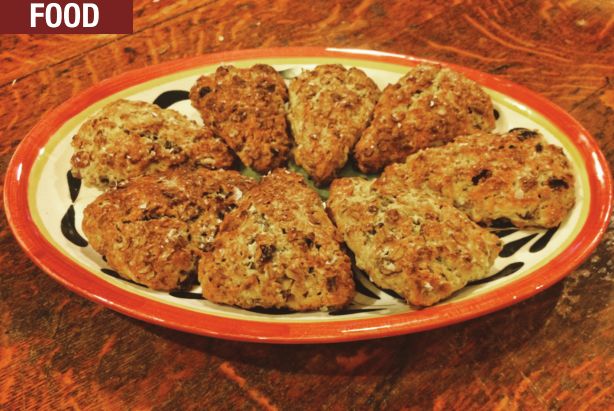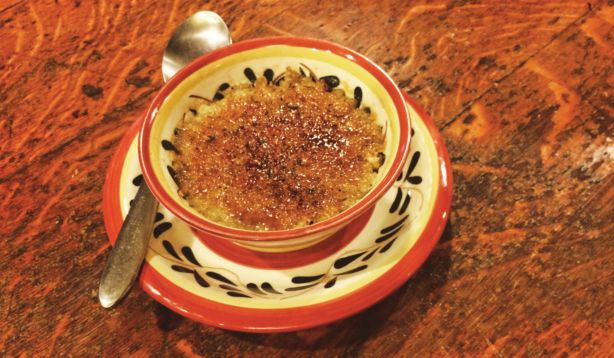
Oatmeal
FOOD | Julianne Glatz
I’ve always despised cold cereal, even as a child. Occasionally I’d be seduced by cheery cartoon characters on commercials and nag my mother into buying Fruit Loops or Rice Krispies. But after I’d eaten a couple spoonfuls and fished out the bananas, the soggy stuff lost its appeal.
Oatmeal was a different story. On cold days, hot oatmeal surrounded by a moat of cold milk and topped with brown sugar that both melted into syrup and providing crunch was not only satisfying, but a bulwark against the trek down our driveway to await the school bus.
When my children were young, I devised a custard variation. Not only was it quickly and easily made (even using old-fashioned oats), the kids loved it, and it added extra nutrition in the form of an egg. I used old-fashioned oats because of their texture and flavor, but quickcooking oats work too.
The recipe is simple – in fact, my children were making it themselves by middle school. It uses more liquid (milk) than the directions on oatmeal boxes because the egg, as with all custards, acts as a thickening agent. Per serving: have ready 1 small beaten egg, honey and flavorings such as vanilla, cinnamon or nutmeg. You can use 1 large beaten egg for 2 servings.
Cook 1/3 cup oatmeal and a pinch of salt in 1 cup milk on the stovetop or in a covered microwavable bowl for 3-5 minutes, until most of the liquid is absorbed and the oatmeal is a desirable consistency. Remove the oatmeal from the heat and whisk in the egg in a thin stream, beating constantly. The heat of the oatmeal will cook the egg. Stir in honey to taste and a few drops of vanilla or pinches of cinnamon or nutmeg as desired. Serve immediately.
My family discovered their ultimate oatmeal in a now-defunct Chicago hotel that became a must-destination largely because of the oatmeal crème brulée on the restaurant’s breakfast menu. Its flavor resembled my custard oatmeal, although the texture was more unctuous. But what really set it apart was the brulée, the clear disc of hard caramelized sugar emblematic of its dessert inspiration. A version can be made running a brown sugar-topped bowl of custard oatmeal under a broiler. To create a true brulée, sprinkle a thin layer of white sugar evenly over the top and caramelize it with a blowtorch.
These two recipes are not only delicious; they take advantage of oatmeal’s texture and keeping quality. The scones are almost as good the day after they’re made as when they’re fresh from the oven. The rolls heat well; any stale leftovers make killer bread pudding or, if made into loaves, French toast.
Oatmeal scones with dried cherries
• 1 1/2 c. old-fashioned rolled oats
• 1/4 c. whole milk
• 1/4 c. heavy cream
• 1 large egg
• 1 1/2 c. unbleached, all-purpose flour
• 1/3 c. packed light brown sugar
• 2 tsp. baking powder, preferably without aluminum salts, such as Rumford
• 1 tsp. salt
• 10 T. cold unsalted butter, cut into bits
• 3/4 c. dried cherries, not tightly packed, or substitute raisins or other dried fruits cut into bite-sized pieces
• Coarse (turbinado) sugar, sometimes labeled Demarara or “Sugar in the Raw,” for sprinkling Preheat the oven to 375 F. Spread the oats evenly on a large baking sheet and toast in the oven until lightly browned and aromatic, about 10-15 minutes. Depending on your oven, you may need to stir them once or twice. Cool the toasted oats to room temperature; set aside 1/4 cup.
Increase the oven temperature to 450 F. In a small bowl, beat together the milk, cream and egg until well combined; set aside 1 tablespoon of the mixture for glazing the scones.
Place the flour, light
brown sugar, baking powder and salt in the bowl of a food processor and
process to combine. Alternatively, combine with a spoon or spatula.
Sprinkle the bits of butter over the top of the dry ingredients. Pulse
the food processor or cut the butter in with two forks or a pastry
blender until the mixture resembles coarse cornmeal. Do NOT over mix.
Place the dry ingredients in a large bowl, add the toasted oats and dried cherries, and stir to combine.
Fold
in the liquid ingredients with a rubber spatula JUST until combined
then knead lightly by hand in the bowl until you have cohesive dough.
Again, do not over-mix. Line a flat work area with a sheet of parchment
or waxed paper and sprinkle 2 tablespoons of the reserved oats into a
roughly 6-inch circle. Turn the dough out onto the center of the oats
and sprinkle with the remaining oats. Gently pat the dough into a circle
about 1-inch thick. It should be approximately 7-inches in diameter.
Cut
the circle into 8 wedges and place on a baking sheet that has been
lined with parchment paper. Brush the tops with the reserved egg/milk
mixture and sprinkle with the coarse sugar. Bake for 13-15 minutes or
until golden brown. Serve the scones warm or at room temperature.
Makes 8 scones.
Adapted from a recipe in Cook’s Illustrated magazine, September/October 2003
Oatmeal maple rolls
• 2 c. boiling water
• 1 c. rolled oats
• 2 T. unsalted butter
• 1/2 c. warm water
• 1 package (2 ¼ tsp.) active dry yeast, not fast-acting
• 1 tsp. sugar
• 1/2 c. pure maple syrup
• 1 T. salt
• 5–6 c. unbleached all-purpose flour or half unbleached and half whole wheat flour (preferably King Arthur White Whole Wheat)
• Melted butter for brushing the balls of dough
•
Additional maple syrup and rolled oats for topping In a large bowl or
bowl of a mixer fitted with a dough hook, pour the boiling water over
the rolled oats. Add the butter and set aside.
In
a small bowl, combine the sugar, yeast and warm water. Let stand for 5
to 10 minutes, or until mixture is bubbly and expanding. If it does not
bubble up, the yeast is inactive. DO NOT proceed with the recipe until
you have active yeast.
When
the yeast has proofed (become bubbly) add it, the maple syrup, salt and
5 cups of the flour to the oatmeal. Knead by hand or in the mixer until
the dough is a smooth and shiny mass, 5 to 10 minutes. You may need to
add up to an additional cup of flour. The dough may be tightly covered
and refrigerated overnight at this point. If refrigerating overnight,
remove from the refrigerator about 2-3 hours to come to room temperature
before proceeding.
Cover
the dough and let rise until doubled in bulk, about 1 to 1 1/2 hours.
If you’ve refrigerated the dough, it doubling in bulk is the crucial
factor, as the total time can vary depending on your refrigerator’s
temperature and how much it might rise in the fridge.
Once the dough has doubled, punch it down and turn onto a lightly floured surface and let it rest for 15 minutes.
Grease
two deep 9-inch cake pans. Divide the dough in half, then divide each
half into 9 equal portions. Form each portion into a ball, brush very
lightly with melted butter, and arrange 9 balls in each cake pan.
Cover the pans and let the dough rise until again doubled in bulk, about 30–45 minutes.
Bake
at 375 F for 30 minutes. Take pans from the oven and brush the tops of
the rolls with maple syrup and sprinkle with rolled oats. Return pans to
the oven and bake for an additional 5 minutes, or until the tops are
golden brown and the rolls sound hollow when tapped.
This
dough can also be formed and baked in two loaf pans. Bake for 40
minutes, brush with the syrup and oats, and return to the oven for 5-10
additional minutes.
Makes 18 rolls.
Contact Julianne Glatz at [email protected].